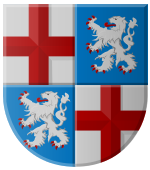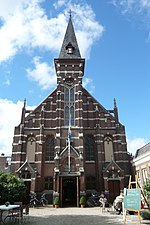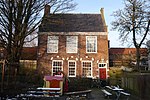Schoterveense Molen, Haarlem

Schoterveense Molen is a windmill in Haarlem located at Wipwatermolen Heussensstraat in the former municipality of Schoten. It is registered as a Rijksmonument. This windmill stands as silent witness to the heritage of a defunct organization called Waterschap De Schoterveenpolder, that ended in 1935. A commemorative plaque was attached in 1891 by the last directors of that organization after some maintenance work was carried out. The polder was once over 206 hectares (515 acres), but has been reduced to half an acre due to surrounding city expansion. Between 1920 and 1923 its pumping function was transferred to an electric pumping station on the Delft canal further west. This made the mill redundant, which was necessary to strip it of its "wind rights" that prevented building expansion in the neighborhood.It is situated quite close to the Huis ter Cleeff and was witness to the inquartering of the Spaniards under the Duke of Alva, which explains why the small canal next to it was called the Spanse-vaart and further towards the river Spaarne a street situated along the former route of the canal is called Spaansevaartstraat. Inspection in the 1950s brought to light some carpenters' marks in the foundations that go back to the 16th-century and as wipmolen De Stoop it was possibly built by the Spaniard troops during the siege of Haarlem.
Excerpt from the Wikipedia article Schoterveense Molen, Haarlem (License: CC BY-SA 3.0, Authors, Images).Schoterveense Molen, Haarlem
Schoterveenpolder, Haarlem
Geographical coordinates (GPS) Address External links Nearby Places Show on map
Geographical coordinates (GPS)
| Latitude | Longitude |
|---|---|
| N 52.398030555556 ° | E 4.6319166666667 ° |
Address
Schoterveense Molen
Schoterveenpolder
2023 JZ Haarlem (Haarlem)
North Holland, Netherlands
Open on Google Maps










